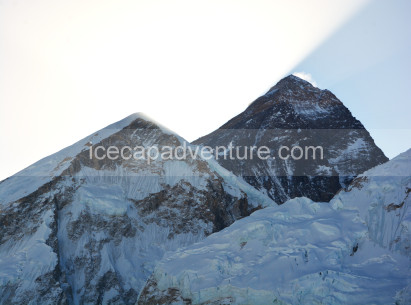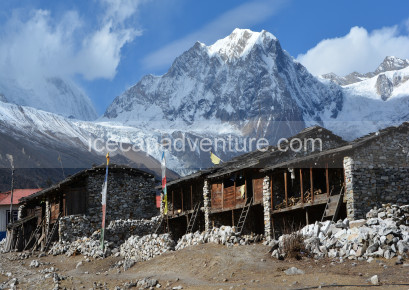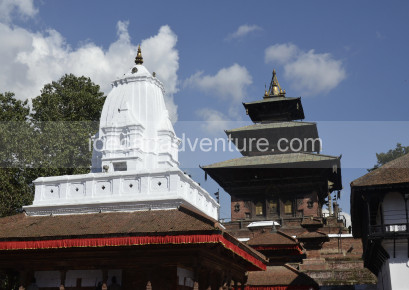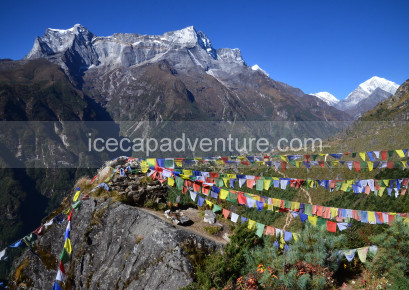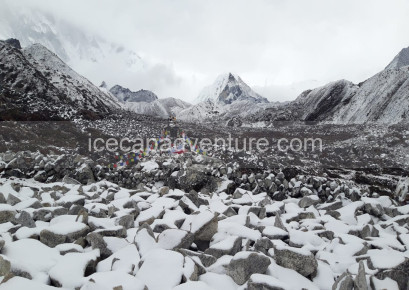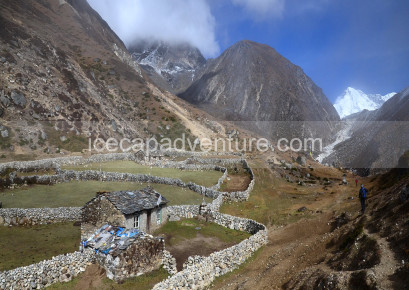.png)
.png)
.png)
.png)
.png)
.png)
.png)
.png)
Conquer the Heights: EBC & Lobuche Peak Climbing
Lobuche Peak Climbing with Everest Base Camp Trek (EBC) is an ideal pick from a bunch of peak climbing options available in Nepal. It presents an exemplary exposure to a peak-climbing adventure in the Khumbu region. Rising tall just above the village, Lobuche Peak has a charm that has attracted a lot of peak climbers and mountaineers.
Ascending to the peak isn’t so specialized; however, the high-height introduction to the rugged territory and erratic climate conditions up there is a genuine test that makes the climb tough. The path from the base camp to the peak offers some eminent perspectives on mountains in the Everest Region. Therefore, we complete the Everest Base Camp Trekking before starting our climb from Lobuche Base Camp to acclimatize ourselves and increase the probability of a successful ascent.
Conquer the Himalayas: Lobuche Peak Climbing Experience
Have you ever dreamed of standing on top of the world, surrounded by majestic peaks and breathtaking views? If so, then Lobuche Peak Climbing might just be the adventure you’ve been searching for. This ultimate Himalayan trekking and climbing experience will take you to the heart of the Everest region, offering a unique opportunity to summit two stunning peaks and explore some of the most beautiful landscapes on the planet.
Everest base camp adventure begins
Everest Base Camp The itinerary will begin in the Kathmandu Valley. The beautiful valley has seven UNESCO World Heritage Site, which we will visit in a span of two days. From Kathmandu, we will take a flight to Lukla. The world’s most dangerous airport for Lukla-to-EBC treks is often known as Lukla. We will travel to the iconic Sherpa settlement of Namche Bazaar, known as the gateway to Everest Base Camp. From there, we will trek through the beautiful Sherpa villages of Dingboche, Lobuche, Chukung, Tinnboche, and Gorakshep.
Highlights of Everest Base Camp Trek with Lobuche East Peak Climbing
- Witness some breathtaking views of towering mountains like Mt. Ama Dablam, Mt. Pumori, and Everest from the highest point of Lobuche top.
- Exploring old Himalayan villages and their significant religious sites.
- Sagarmatha National Park, sherpa villages, Sherpa culture, lifestyle.
- The mind – blowing mountain views and precipitous landscape.
- Exciting and challenging experience, during EBC Trek with Island Peak Climbing.
- Explore the mesmerizing prayer wheels, colorful flags, mani stones, and huge suspension bridges.
- Get amazed by the stunning diversity of flora and animals, including musk deer, colorful pheasants, snow leopards, and Himalayan Thar.
Highlights of the Trip:
- Scenic mountain flight of Kathmandu to Lukla to Kathmandu.
- Get to see the amazing mountain views, gorgeous landscapes, and a unique climbing experience.
- Get overly satisfied by heavenly views of Mt. Everest, Mt. Lhotse, Mt. Makalu, Mt. Nuptse, Mt. Amadablam, Mt. Pumori, and several more peaks.
- Pass just by the world's highest glacier, Khumbu Glacier.
- Hike up to Kala Patthar for a panoramic view of mountains in the Everest region.
1
We will be waiting to welcome you at Tribhuvan International Airport, Kathmandu, where you will be greeted with a traditional Nepali flower garland to mark your arrival. After the warm welcome, we will drive you to your hotel, approximately 30 minutes during the day and 20 minutes at night.
Upon reaching the hotel, you will be offered welcome drinks and biscuits, followed by the settlement of your rooms. Once settled, please join us back in the lobby or meeting hall for a briefing about your trekking and tour program on the Everest Base Camp (EBC) + Lobuche Peak Climbing, including an introduction to your trekking guide and other relevant details. After the briefing, you will have the opportunity to check your trekking equipment with your guide.
Note: If you arrive in Kathmandu at night, these activities will be scheduled for the following day after breakfast and meals.
.png)
.png)
.png)
.png)
2
After breakfast at the hotel, you will have time to explore Kathmandu’s cultural heritage sites, such as Kathmandu Durbar Square, Swayambhunath (Monkey Temple), or Boudhanath Stupa, and you will have the day to prepare for your trek.
Our team will assist you in checking your gear and ensuring you have all the necessary equipment for the journey ahead. If you need to buy or rent any trekking gear, we will guide you to the best shops in Thamel, where you can find quality items at reasonable prices.
In the evening, your trekking guide will conduct a final briefing about the trek, including route details, safety measures, and expected weather conditions. Overnight stay at a hotel in Kathmandu
.png)
.png)
.png)
.png)
3
Begin your adventure with an early morning 45-minute scenic flight from Kathmandu to Lukla (2,860 m), famous for its stunning mountain views and dramatic runway. Upon arrival in Lukla, meet your trekking team and begin a gentle 3–4 hour trek to Phakding (2,610 m). The trail winds through lush pine forests, small villages, and terraced fields, following the Dudh Koshi River. Along the way, trekkers cross suspension bridges and enjoy views of snow-capped peaks like Kusum Kanguru and Kongde Ri. Phakding is a quaint village that serves as a perfect first night stop, offering comfortable teahouse accommodations and warm meals.
Highlights of the Day:
-
Scenic flight to Lukla with panoramic Himalayan views.
-
Trek through forests, terraced fields, and riverside villages.
-
Cross suspension bridges over the Dudh Koshi River.
-
Enjoy views of Kusum Kanguru, Kongde Ri, and surrounding peaks.
-
First night stop at Phakding (2,610 m) with cozy teahouses.
.png)
.png)
.png)
.png)
4
After breakfast in Phakding (2,610 m), embark on a challenging 5–6 hour trek to Namche Bazaar (3,440 m), the vibrant gateway to the Everest region. The trail follows the Dudh Koshi River, crossing suspension bridges and passing through small Sherpa villages, monasteries, and prayer wheels. As you ascend, the trail becomes steeper, preparing trekkers for higher altitudes ahead. Along the way, enjoy breathtaking views of Thamserku, Kwangde Ri, and Ama Dablam, iconic peaks of the Khumbu region. Namche Bazaar is a lively Sherpa town with shops, bakeries, and teahouses, offering a perfect place to rest, acclimatize, and explore local culture.
Highlights of the Day:
-
Trek along the Dudh Koshi River, crossing multiple suspension bridges.
-
Pass through traditional Sherpa villages and monasteries.
-
Panoramic views of Thamserku, Kwangde Ri, and Ama Dablam.
-
Explore Namche Bazaar (3,440 m), the cultural and commercial hub of the region.
-
Overnight stay at teahouses with warm meals and local hospitality.
.png)
.png)
.png)
.png)
5
After breakfast in Namche Bazaar (3,440 m), take a half-day excursion to Khumjung village (3,780 m), a traditional Sherpa settlement renowned for its ancient monasteries and stunning Himalayan views. Visit the Khumjung Monastery, famous for housing a reputed yet-toeric Yeti scalp, and explore the village to experience Sherpa culture, traditional stone houses, and terraced farms.
The day is primarily for acclimatization, allowing your body to adjust to higher altitudes while enjoying gentle walks around Namche and Khumjung. Trekkers are rewarded with panoramic views of Everest, Ama Dablam, Thamserku, and Kusum Kanguru, making it an ideal combination of cultural immersion and high-altitude acclimatization. Return to Namche Bazaar in the afternoon for leisure, local shopping, or tea house relaxation.
Highlights of the Day:
-
Visit Khumjung village and monastery, experiencing traditional Sherpa culture.
-
Acclimatization day to adjust to high altitude.
-
Stunning views of Everest, Ama Dablam, Thamserku, and Kusum Kanguru.
-
Explore Namche Bazaar’s local shops, cafés, and bustling market.
-
Gentle trekking for cultural exploration and photography.
.png)
.png)
.png)
.png)
6
After breakfast in Namche Bazaar (3,440 m), start your 5–6 hour trek to Tengboche (3,700 m), a sacred Sherpa village famous for the Tengboche Monastery, the largest in the Khumbu region. The trail ascends gently at first, passing through Junbesi and pine forests, then climbs steadily with occasional steps and ridges, providing stunning views of Ama Dablam, Thamserku, and Kwangde Ri.
Tengboche is renowned for its spiritual atmosphere, traditional stone houses, and panoramic Himalayan vistas. The Tengboche Monastery, perched on a ridge, is a perfect spot for photography, cultural immersion, and meditation, offering a sense of serenity amidst the towering peaks. After exploring the monastery, enjoy the sunset over the mountains, a highlight for trekkers before settling in for tea house accommodation and a warm dinner.
Highlights of the Day:
-
Trek through pine forests and scenic ridges.
-
Arrival at Tengboche Monastery (3,700 m), the spiritual heart of the Khumbu region.
-
Panoramic views of Ama Dablam, Thamserku, and Kwangde Ri.
-
Cultural experience of Sherpa village life.
-
Overnight stay at teahouses with mountain views.
.png)
.png)
.png)
.png)
7
After breakfast in Tengboche (3,700 m), embark on a 5–6 hour trek to Dingboche (4,410 m), following a scenic trail that gradually climbs through the Imja Khola Valley. The route passes through Sherpa villages, mani walls, and suspension bridges, offering trekkers an immersive experience of Khumbu culture and Himalayan landscapes.
As the altitude increases, the vegetation becomes sparse, and trekkers enter the alpine zone, surrounded by rocky terrain and panoramic views of Ama Dablam, Lhotse, and Island Peak (Imja Tse). Dingboche is a charming village with stone-built houses, teahouses, and Buddhist prayer flags, providing a perfect spot for acclimatization and rest before venturing higher.
Highlights of the Day:
-
Trek through Sherpa villages, mani walls, and alpine landscapes.
-
Panoramic views of Ama Dablam, Lhotse, and Island Peak (Imja Tse).
-
Arrival at Dingboche (4,410 m), ideal for acclimatization.
-
Experience local Sherpa culture and traditional teahouse hospitality.
-
Gentle evening walks around the village to aid altitude acclimatization.
.png)
.png)
.png)
.png)
8
After breakfast in Dingboche (4,410 m), spend the day acclimatizing to high altitude with a short excursion to Nagarjun Hill (around 5,100 m). This gentle hike is designed to help your body adjust to the thin air, while providing trekkers with spectacular views of surrounding peaks, including Ama Dablam, Lhotse, and Island Peak (Imja Tse).
The Nagarjun hike is out-and-back, meaning you return to Dingboche for the night. Along the trail, enjoy the alpine terrain, moraine landscapes, and scattered prayer flags, offering both physical preparation and scenic photography opportunities. The afternoon can be spent resting in Dingboche, exploring the village, or taking a short walk around the fields and prayer walls to further aid acclimatization.
Highlights of the Day:
-
Gentle acclimatization hike to Nagarjun Hill (5,100 m).
-
Panoramic views of Ama Dablam, Lhotse, Island Peak, and surrounding glaciers.
-
Experience alpine terrain and traditional Dingboche village life.
-
Short hikes around the village to aid altitude acclimatization.
-
Evening at teahouses with warm meals and mountain views.
.png)
.png)
.png)
.png)
9
After breakfast in Dingboche (4,410 m), set out on a 4–5 hour trek to Lobuche (4,910 m). The trail gradually ascends through the rocky moraine landscape of the Khumbu region, offering trekkers panoramic views of Ama Dablam, Lhotse, and the Khumbu Glacier. Along the way, you pass through small settlements and memorials for climbers, reflecting the Everest region’s rich mountaineering history.
Lobuche is a small village situated on the Khumbu Glacier moraine, providing a strategic stop for trekkers en route to Everest Base Camp. The village offers teahouse accommodations with basic facilities, allowing trekkers to rest and acclimatize further before the high-altitude trek ahead.
Highlights of the Day:
-
Trek through moraine landscapes with Himalayan glacier views.
-
Panoramic vistas of Ama Dablam, Lhotse, and surrounding peaks.
-
Pass mountaineering memorials, highlighting the history of Everest expeditions.
-
Arrival at Lobuche (4,910 m), a key stop before higher altitude trekking.
-
Overnight stay in cozy teahouses with mountain views.
.png)
.png)
.png)
.png)
10
After breakfast in Lobuche (4,910 m), embark on a 3–4 hour trek to Gorak Shep (5,140 m), the last settlement before Everest Base Camp (EBC). The trail passes through rocky moraine landscapes, glacial valleys, and alpine terrain, offering breathtaking views of Pumori, Lingtren, Nuptse, and Khumbu Glacier.
Upon arrival at Gorak Shep, take a short rest and have lunch at a teahouse, then continue on a 2–3 hour out-and-back hike to Everest Base Camp (5,364 m). At EBC, trekkers are rewarded with close-up views of the Khumbu Icefall, towering peaks, and the surrounding glacial expanse. This is a once-in-a-lifetime experience, marking the culmination of the classic Everest region trek. After photos and exploration, return to Gorak Shep for overnight stay, enjoying the high-altitude environment and spectacular mountain scenery.
Highlights of the Day:
-
Trek through rocky moraine and glacial valleys with panoramic Himalayan views.
-
Arrival at Gorak Shep (5,140 m), the last settlement before Everest Base Camp.
-
Hike to Everest Base Camp (5,364 m) for stunning views of Khumbu Glacier, Nuptse, and Everest.
-
Experience the Himalayan environment and glacial landscapes.
-
Overnight stay at Gorak Shep with mountain views.
.png)
.png)
.png)
.png)
11
After an early breakfast in Gorak Shep (5,140 m), start the 3–4 hour climb to Kala Patthar (5,545 m), a small peak famous for offering the best panoramic views of Mount Everest, Lhotse, Nuptse, and Pumori. The ascent involves rocky and steep terrain, and the early morning climb allows trekkers to witness a spectacular sunrise over the Himalayas.
After soaking in the breathtaking views from Kala Patthar, descend carefully back to Gorak Shep for a short rest, then continue trekking down to Lobuche (4,950 m) for your overnight stay. This day combines the ultimate high-altitude experience with descending to a comfortable lodge, allowing your body to recover after the summit hike.
Highlights of the Day:
-
Early morning sunrise climb to Kala Patthar (5,545 m).
-
Unparalleled panoramic views of Everest, Lhotse, Nuptse, and surrounding peaks.
-
Trek through rocky terrain and high-altitude moraine landscapes.
-
Descent to Lobuche (4,950 m) for a comfortable overnight stay.
-
Capture incredible photographs of the Himalayan range.
.png)
.png)
.png)
.png)
12
After breakfast in Lobuche (4,950 m), begin the trek to High Camp (5,600 m), typically used as the final overnight stop before summit attempts of nearby peaks like Island Peak or Mera Peak. The trail ascends steadily through rocky moraine, glacial terrain, and scattered ice fields, providing trekkers with dramatic close-up views of surrounding peaks including Lobuche East, Pumori, Nuptse, and Everest.
High Camp offers a strategic high-altitude location for climbers and trekkers, allowing time to rest and acclimatize for the early morning summit climb. The environment is stark but majestic, with snow-dusted peaks, glaciers, and clear views of the Himalayan horizon creating a truly memorable high-altitude experience.
Highlights of the Day:
-
Trek through rocky moraine and glacial terrain.
-
Panoramic views of Lobuche East, Pumori, Nuptse, and Everest.
-
Overnight stay at High Camp (5,600 m) for summit preparation.
-
Experience the dramatic high-altitude Himalayan environment.
-
Acclimatization for summit attempts or high-altitude trekking.
.png)
.png)
.png)
.png)
13
After an early breakfast at High Camp (5,600 m), begin the final ascent to Lobuche Summit (6,119 m). The climb is steep and challenging, taking 3–4 hours depending on conditions, with trekkers rewarded with breathtaking panoramic views of Everest, Lhotse, Nuptse, and surrounding Himalayan peaks. Standing atop Lobuche provides a sense of accomplishment and unmatched Himalayan vistas, ideal for photography and reflection.
After soaking in the summit views, descend carefully back to Lobuche Base Camp (4,950 m) for a short rest and lunch. Continue trekking down the valley to Pheriche (4,371 m), passing through moraine landscapes, glacial streams, and alpine scenery. Pheriche is a charming village with teahouses and lodges, providing a comfortable spot to rest and recover after the summit day.
Highlights of the Day:
-
Early morning summit of Lobuche (6,119 m) for panoramic Himalayan views.
-
Witness Everest, Lhotse, Nuptse, and surrounding peaks up close.
-
Descent through moraine and alpine terrain to Base Camp.
-
Trek to Pheriche (4,371 m) for overnight stay and recovery.
-
Experience high-altitude adventure and breathtaking mountain landscapes.
.png)
.png)
.png)
.png)
14
A reserve day is scheduled during high-altitude trekking itineraries to accommodate weather delays, acclimatization needs, or unforeseen circumstances. This day provides flexibility, allowing trekkers to rest, recover, or complete optional excursions without impacting the overall schedule.
Trekkers can spend the day relaxing at the lodge, taking short walks around the village, or exploring nearby viewpoints, depending on their location. It’s also an excellent opportunity to adjust to altitude, enjoy the Himalayan scenery, and take photographs.
Highlights of the Day:
-
Flexible reserve day for rest, acclimatization, or unforeseen delays.
-
Optional short hikes or cultural visits in the local area.
-
Time to photograph the mountains, village life, and surrounding landscapes.
-
Relaxation and recovery to ensure readiness for upcoming trekking days.
.png)
.png)
.png)
.png)
15
After breakfast in Pheriche (4,371 m), begin the 5–6 hour descent to Namche Bazaar (3,440 m). The trail winds through the Imja Khola and Dudh Koshi river valleys, passing Sherpa villages, mani walls, and suspension bridges along the way. The gradual downhill trek allows trekkers to relax their muscles after high-altitude exertion while still enjoying stunning Himalayan landscapes.
Upon arrival in Namche Bazaar, take time to explore the bustling Sherpa market, local shops, and cafés, or simply rest at your teahouse, soaking in the panoramic views of Thamserku, Kusum Kanguru, and Ama Dablam. This day is ideal for recovery and acclimatization before continuing the descent toward Lukla.
Highlights of the Day:
-
Scenic descent through alpine valleys and Sherpa villages.
-
Cross suspension bridges and pass mani walls along the trail.
-
Explore Namche Bazaar (3,440 m) and its vibrant Sherpa culture.
-
Panoramic mountain views including Thamserku, Kusum Kanguru, and Ama Dablam.
-
Overnight stay at a teahouse in Namche Bazaar for comfort and relaxation.
.png)
.png)
.png)
.png)
16
After breakfast in Namche Bazaar (3,440 m), start the 5–6 hour descent to Lukla (2,860 m), retracing the scenic trail along the Dudh Koshi River. The route passes through Sherpa villages, terraced fields, and suspension bridges, offering a last chance to enjoy the Khumbu Valley’s stunning landscapes. The descent is gradual but requires careful footing, allowing trekkers to relax after several days of high-altitude trekking.
Upon arrival in Lukla, trekkers can celebrate the completion of the trek, visit local shops, and interact with fellow trekkers, or simply rest at a lodge. This day marks the end of the Everest region trek, preparing travelers for their flight back to Kathmandu.
Highlights of the Day:
-
Gradual descent through Sherpa villages, alpine forests, and terraced fields.
-
Cross multiple suspension bridges and mani walls along the Dudh Koshi River.
-
Enjoy panoramic views of Ama Dablam, Thamserku, and Kusum Kanguru one last time.
-
Arrival in Lukla (2,860 m) and celebration of trek completion.
-
Overnight stay in comfortable teahouses with mountain views.
.png)
.png)
.png)
.png)
17
After completing your trek and staying overnight in Lukla (2,860m), board a morning flight to Kathmandu (1,350m). The flight takes approximately 45 minutes and offers breathtaking aerial views of the Himalayan range, including Everest, Lhotse, and surrounding peaks, as you descend toward the Kathmandu Valley.
Upon arrival in Kathmandu, you’ll be transferred to your hotel, where you can rest, refresh, and reflect on your trekking journey. The day is ideal for packing, sightseeing, or enjoying the local culture and cuisine in the capital city.
Highlights of the Day:
-
Scenic 45-minute flight over the Himalayas with panoramic mountain views.
-
Enjoy aerial perspectives of snow-capped peaks, glaciers, and remote valleys.
-
Arrival in Kathmandu, offering urban comforts after the trek.
-
Optional sightseeing, shopping, and cultural experiences in Kathmandu.
.png)
.png)
.png)
.png)
18
After breakfast at your hotel in Kathmandu (1,350m), you will be transferred to Tribhuvan International Airport for your onward journey. Depending on your flight schedule, you may have a chance for last-minute shopping, sightseeing, or enjoying local refreshments before departure.
Airport staff or your guide will assist with check-in and departure formalities, ensuring a smooth and stress-free experience. This marks the conclusion of your memorable Nepal trekking and cultural journey, filled with breathtaking Himalayan landscapes, rich village cultures, and spiritual experiences.
Highlights of the Day:
-
Final morning in Kathmandu to relax or explore.
-
Transfer to Tribhuvan International Airport for departure.
-
Reflect on your trekking adventure and cultural experiences in Nepal.
-
Smooth departure with assistance for check-in and airport formalities.
.png)
.png)

Didn’t find what you were looking for?
So why not plan your own trip. It takes only 2 minutes.- Airport Pick up and transfers to hotel and briefings with tea and biscuits in Kathmandu.
- Full board meals during the trekking and climbing such as Breakfast, lunch and dinner .
- Properly 3 times tea and coffee whatever hot drinks are available.
- All accommodation hotel in Kathmandu, Trekking and Climbing.
- Garbage Management and Garbage Disposal Fee.
- All transportation with AC deluxe from the starting to ending points of the trip.
- Domestic flight tickets from Kathmandu to Lukla & Lukla to Kathmandu.
- Experienced Base Camp Sirdar, Manager, Cook, Camp-2 Cook and Kitchen helpers.
- Walkie-Talkie for communicating from Base Camp to Mountain and Mountain to Base Camp.
- Experience professional climbing / trekking guide, sub guide and porters.
- All climbing permits and trekking permit whatever needed.
- Down Sleeping bag (-20), and Company’s Duffel Bag (if required).
- Government Taxes and Company Service Charge.
- First Aid Kit for staff
- Peak summit certificate after the successful summit of the peak.
- All international flight tickets and Nepal entry visa fees.
- Lunch and dinner in Kathmandu.
- All hard drinks such as : Mineral water, whisky, rum, cola, fanta, etc.
- Personal Travel Insurance and High-Altitude Insurance (Accident, Medical, and Emergency Rescue Evacuation).
- All entrance fees during the sightseeing in Katmandu and until finished.
- Personal expenses like hot shower and battery charge / wifi.
- Personal climbing equipment and insurance.
- Any emergency rescue evacuation and extra cost offering from unfavourable circumstances such as bad weather
- Personal tips for trekking staff.

✅ Clothing
-
Base Layers (Thermal Tops & Bottoms)
-
Trekking Shirts (Long & Short Sleeves)
-
Fleece Jacket / Warm Mid-layer – For insulation.
-
Down Jacket – Essential for nights above 3,500m.
-
Waterproof & Windproof Jacket (with hood).
-
Trekking Pants (lightweight, quick-drying).
-
Warm Trekking Pants (for high altitude).
-
Waterproof Pants (for rain/snow).
-
Underwear – Comfortable, quick-dry.
-
Sports Bras (for women).
✅ Head & Hand Wear
-
Warm Hat / Beanie and Sun Hat / Cap.
-
Buff / Neck Gaiter / Scarf.
-
Sunglasses and Gloves 2 pairs
✅ Footwear
-
Trekking Boots – Sturdy, waterproof, broken-in.
-
Lightweight Shoes / Sandals – For camp/teahouse.
-
Warm Trekking Socks – At least 4–5 pairs.
✅ Sleeping & Bags
-
Sleeping Bag (Down -15°C) and Liner.
-
Duffel Bag (carried by porter).
-
Daypack (30–40L) – For personal items.
-
Rain Cover for Backpack.
✅ Trekking Gear
-
Trekking Poles & Gaiters – For snow or muddy conditions.
-
Headlamp (with extra batteries).
-
Water Bottles (2–3 litres) and Water Purification.
-
Personal First Aid Kit
-
Snacks / Energy Bars / Dry Fruits.
✅ Accessories & Personal Items
-
Sunscreen (SPF 30–50) and Lip Balm with SPF.
-
Toiletries and Hand Sanitiser.
-
Towel (quick-dry) and Toilet Paper
-
Camera / Power Bank / Solar Charger.
✅ Documents & Money
-
Valid Passport and Visa.
-
Travel Insurance (covers high-altitude & helicopter rescue).
-
Cash (Nepali Rupees) – For personal expenses.
Good to Know - EBC + Lobuche Peak Climbing
Best Seasons to Trek and Climb
The ideal seasons are spring, from March to May, and autumn, from September to November. These months provide the most stable weather, clear skies, and favorable climbing conditions. Spring offers warmer days and the chance to see Everest’s climbing season in action, while autumn brings crisp air and stunning visibility. Winter conditions make the ascent far more difficult, while monsoon rains create risks of landslides and poor visibility.
Altitude Awareness
Everest Base Camp itself sits at 5,364 meters, but summiting Lobuche Peak requires acclimatization for altitudes above 6,000 meters. The risk of altitude sickness is significant, so a carefully designed itinerary with rest and acclimatization days is crucial. The climbing section adds another level of exposure, where physical strain and altitude can become demanding.
Physical Fitness
This is a trek and climb for adventurers with a strong fitness base. The trekking portion is moderate to challenging, requiring stamina for long days of walking, while the climb involves technical sections that demand strength, endurance, and confidence with basic mountaineering techniques. Prior experience with high-altitude trekking is highly recommended, and climbers should be comfortable using ropes, crampons, and ice axes.
Permits Required
Along with the Sagarmatha National Park Entry Permit and the Khumbu Pasang Lhamu Rural Municipality Permit for the trekking portion, climbers also need a climbing permit for Lobuche Peak issued by the Nepal Mountaineering Association (NMA). These permits are generally arranged through trekking and climbing agencies in Kathmandu.
Accommodation & Meals
During the trek, tea houses provide accommodation and meals along the Everest Base Camp trail. Meals include dal bhat, soups, noodles, and a range of hot drinks. On the climbing portion, basic tented camps are set up near Lobuche Peak, and food is prepared by climbing staff. The transition from cozy tea houses to rugged camps highlights the expedition-style nature of the climb.
Drinking Water
Water is available at tea houses along the trekking route, though purification is strongly advised. Trekkers often carry tablets or filters to ensure safety. At climbing camps, boiled water is typically provided by the support team. Staying well hydrated is especially important at high altitudes to aid acclimatization.
Packing & Gears
Standard trekking gear is needed for the journey to Everest Base Camp, including sturdy boots, layered clothing, sleeping bags, rain gear, and sun protection. For the climb itself, technical equipment such as crampons, harnesses, helmets, carabiners, ropes, and ice axes is essential. Most climbing groups provide or rent this gear, but climbers are encouraged to bring personal items such as boots suited for high-altitude mountaineering.
Flight & Transportation
The adventure begins with a scenic flight from Kathmandu or Ramechhap to Lukla, the entry point to the Khumbu Valley. From there, trekkers follow the legendary trail through Namche Bazaar, Tengboche, Dingboche, and Gorakshep before reaching Everest Base Camp. Afterward, the route turns toward Lobuche for the climb. Following the summit, trekkers either retrace their steps back to Lukla or arrange a helicopter return for a quicker journey.
Connectivity
Mobile networks and Wi-Fi are available in many villages along the Everest Base Camp trail, though the service is limited and becomes unreliable as you gain altitude. During the climbing portion near Lobuche, connectivity is not available, giving climbers a true expedition atmosphere.
Travel Insurance
Comprehensive insurance is mandatory for this adventure, covering trekking and climbing up to at least 6,500 meters. Policies should include emergency evacuation by helicopter, medical treatment, trip cancellation, and climbing activities. Since this trip involves both trekking and mountaineering, climbers must confirm that their insurance covers technical climbs.
Trek & Climb Cost Overview
The cost for Everest Base Camp with Lobuche Peak Climbing is higher than standard treks due to the climbing permit, technical gear, guides, and additional logistics. Prices generally range from $2,500 to $4,500 depending on services, group size, and itinerary length. This includes permits, accommodations, meals, climbing gear, guides, porters, and often a contingency day for the summit attempt.
Why Choose EBC with Lobuche Peak?
This adventure is perfect for those who want more than the classic trek. It combines the cultural richness of the Khumbu region, the legendary destination of Everest Base Camp, and the personal triumph of standing atop a Himalayan peak above 6,000 meters. Summiting Lobuche offers spectacular panoramic views of Everest, Lhotse, Nuptse, Ama Dablam, and beyond, making it a life-changing achievement for mountaineers and trekkers alike.

